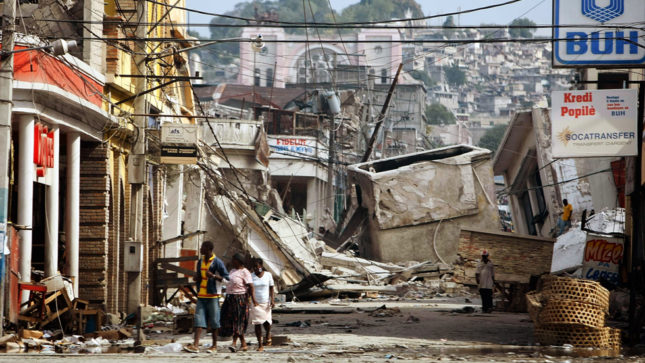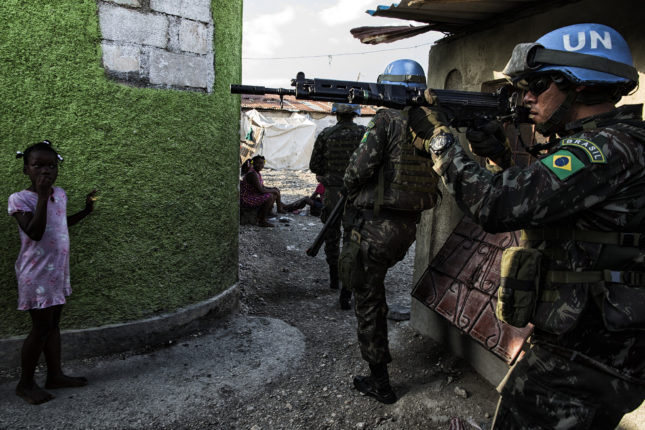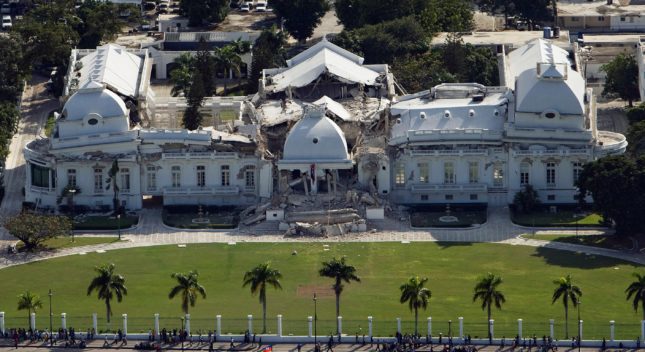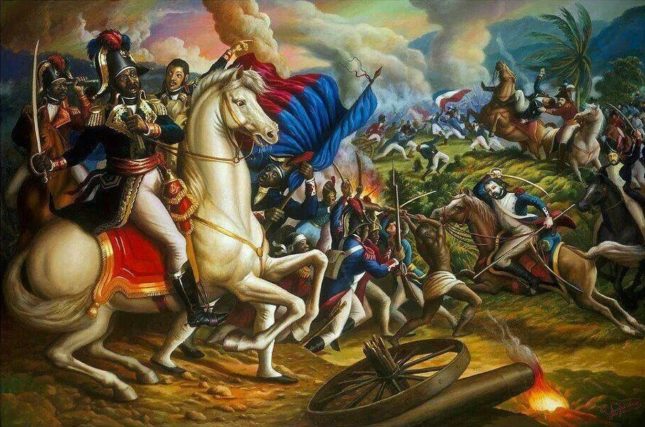
One would think that, now that the despised 14-year long United Nations Mission for the (de)Stabilization of Haiti (MINUSTAH) has been forced to shut down, Haiti would be on the road to some modest, sustained, recovery from the devastating Jan. 12, 2010 earthquake. It is not. The Republic of Haiti has never been in greater danger than it is now.
From MINUSTAH to MINUJUSTH
The proverb, “Speak softly and carry a big stick; you will go far,” is actually West African. It should resonate with Haitians, who have lived with colonists long enough to know that they can tone down their rhetoric as they prepare to administer their coup de grace. Consider for example the U.S. State Department’s press release on the inauguration of the UN Mission for Justice Support in Haiti (MINUJUSTH) on Oct. 16, 2017, one day after MINUSTAH’s departure. “The United States is a longstanding partner of Haiti,” the press release coos, but it goes on to prove that the old master has not become a partner, with another statement: “We commend MINUSTAH for the contributions toward advancing Haiti’s long-term security, democratic development, and economic growth.” This is not something anyone would say except a colonial master who is satisfied with his work. According to the UN’s own situation report in May 2017, Haiti, a country of about 10 million people, had more than 2.35 million people who were “severely food insecure,” 143,110 severely malnourished, 49,691 still internally displaced from the earthquake, 4,200 homeless since Hurricane Matthew, and 10,512 prisoners, 71 percent of whom had not been tried. A UN human rights report on Haiti cited the arbitrary arrests, abuses in detention, and complete lack of accountability.

The smaller MINUJUSTH mission is more insidious than MINUSTAH. The troops too have undergone a name change to police in “formed police units” (FPU). Nevertheless they are part of an occupying foreign army, with all the attendant implications. At 980, the FPU police far outnumber the 295 so-called individual police officers. This occupying force will merge with the Haitian National Police (HNP) and share the same facilities. Another 351 military experts go by the softer title of civilian staff; this body provides the UN a means to insert members of private military and security companies (PMSC) like DynCorp into Haiti.
Regardless of the sheep’s clothing, MINUJUSTH operates under Chapter VII of the UN Charter, which allows the use of military force and is illegally applied in a country not at war. MINUJUSTH has no set departure date because it is permanent. Its real jobs are to change the Haitian Constitution and continue to organize elections that undermine Haitian independence. According to the U.S. State Department, MINUJUSTH will “focus on developing the Haitian National Police.” This is puzzling, given the 15,000-strong domestic force that the UN and DynCorp have already built, until one understands that the plan is to double the HNP leadership from 1,649 to 2,349 and create a permanent corps of corrupt Haitians who are subservient to the occupation. In keeping with the colonial mission, the new UN Special Envoy to Haiti, to replace Bill Clinton, is the Bush-Clinton approved globalist Josette Sheeran, who was Under Secretary of State for Condoleeza Rice in 2005-2007 and the Executive Director of the UN World Food Program from 2007-2012 when Clinton’s good friend Ban Ki-moon was UN Secretary General.
How many Haitians are there left?
To examine its handiwork, the international community, with support from the World Bank, will soon carry out its first census survey of Haiti since the 2010 earthquake. According to World Bank Country Director for Haiti, Anabela Abreu, this census is meant to illustrate “the importance of Haiti’s partnership between the government and its development partners.” Oh yes, the word partner again, instead of master. Haiti has seen more deaths in the last eight years than at any other time, starting with the estimated 200,000 to 300,000 Haitians who died from the earthquake. Subsequently more than 10,000 succumbed to UN-introduced cholera epidemics. Another 86,000 Haitians suffer from HIV infections. Some of them are actively studied by an outfit called Haitian Studies of Kaposi Syndrome and Opportunistic Infections (GHESKIO), which appears to do research on anti-retroviral drug development. GHESKIO receives more USAID funding than any other organization in Haiti. To my knowledge, this research requires none of the usual oversights associated with medical studies on humans.
Haitians fought to make the elections free and fair, to no avail.
The international occupation has encouraged the emigration of more than 170,000 middle class Haitians and educated youths since the earthquake. Latin American countries, like Brazil, Chile, Ecuador, and Mexico have joined the US, France, and Canada as destinations for Haitians. The incentive for the Haitian Vichy government is that its diaspora provides more than $2 billion a year in remittances, roughly 20% of its GDP, and a return of about $1,000 per exiled person per year. As a result, any threat to repatriate Haitian citizens, like U.S. President Donald Trump’s racist removal of the temporary protected status (TPS) of almost 60,000 Haitians, represents tremendous arm-twisting of the international occupation’s Haitian surrogates. Simultaneously with the export of Haiti’s middle class, the Dominican Republic, with UN support, has shipped more than 192,685 people into Haiti since 2015, mostly unskilled workers, many of whom speak only Spanish. In effect, with each passing day, the Haitian population is being degraded and reduced to unskilled laborers, a military and police middle class, and a parasitic elite. The census numbers will tell none of this, of course. They will likely show a population with a slightly lower than expected growth.
Elections are for fools and crooks
Back in January 2015, the Republic of Haiti had been unraveled to such a degree that, of an original 1,500 elected officials, the only ones left were the fraudulently elected President, Michel Martelly, and 10 senators who could not function because they lacked a quorum. In retrospect, that scenario was more benign than the current situation. In 2015-2016, a series of fraudulent elections populated, not only the presidency, but also the parliament and local executive positions with a gallery of rogues. Haitians fought to make the elections free and fair, to no avail. In effect, a corrupt group of international observers, together with the UN, which handled the ballots, have forced a series of mostly corrupt officials, highly vulnerable to blackmail, into office throughout the entire Haitian territory. The current crew of officials are at best a parody of a government. They have allocated $8.5 million in 2018 for a new Haitian army that is expected to grow from 500 to 5,000 troops. These funds are supposed to come from Haitian coffers, but they are probably foreign. Mr. Jodel Lesage, a former colonel of the disbanded bloody 1995 army, heads the new army. As an insult to Haiti’s sovereignty, he marched a group of his camouflaged charges through Cap Haïtien on the Nov. 18, 2017 anniversary of the Bataille de Vertières.
My palace, my palace!

President René Préval, who appeared to have lost his mind immediately after the earthquake and went around screaming “My palace, my palace!” became a national joke and an inspiration for one of my satirical plays. He went on to support a state of emergency that brought into existence Bill Clinton’s infamous Interim Haiti Recovery Commission (I-HRC). About $9.7 billion of international aid have disappeared into the I-HRC and are still unaccounted for. Mr. Préval died in 2017. Perhaps he will rest in peace. The obsession with palaces continues in the political class, which saw fit to break new ground for a new national palace today, on the 8th anniversary of the earthquake. According to Haiti’s recently installed President, Jovenel Moïse, the new building represents a “link between history, culture, and the future.” Indeed it does. When Haiti was truly independent, its national palace was a modest gingerbread house. The monstrous white neoclassical palace was built in 1918, during the first US occupation of Haiti, which lasted from 1915-1934. Then too, a Vichy administration needed to hide behind a façade of power.
The unending revolution

Two hundred and fourteen years after Haitian Independence, Haitians are still paying the price for having fought slavery and for having won that fight. The former colonists France and Spain have returned to make Haiti a free for all. The United States and Canada are there too. This is to be expected. Almost every former European colony has had to fight for its independence more than once. Cuba fought Spain, Vietnam fought France, and then they had to fight again. Independence is never won. In Haiti, this ongoing struggle is part of the fabric of our history. If we successfully did it when we were slaves, then we can do it again. We can never give up that fight. Haiti has been a beacon for human rights. When everybody was giving lip service to the rights of men, we are the ones who stepped up and said most persuasively that there was no place for slavery in the rights of men. Yet slavery persists. It was unacceptable back in the late 18th century, and it is unacceptable now. The colonists are returning as international gangs. People all over the world must also join to fight them.
Dady Chery is the co-editor of News Junkie Post, where this article first appeared, and the author of We Have Dared to Be Free.










